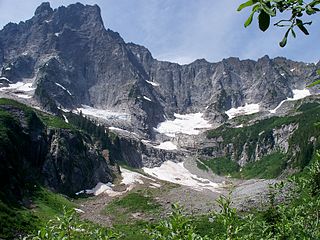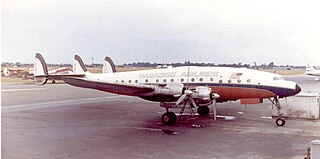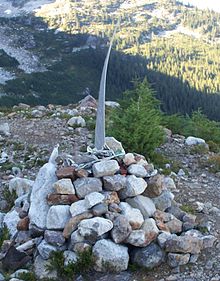
United Air Lines Flight 409 was a scheduled flight which originated in New York City, New York. The final flight destination was San Francisco, California, with stops in Chicago, Denver and Salt Lake City. The aircraft operating the service, a Douglas DC-4 propliner, registration N30062, crashed into Medicine Bow Peak, near Laramie, Wyoming, on October 6, 1955, killing all 66 people on board. The victims included five female members of the Mormon Tabernacle Choir and military personnel. At the time, this was the deadliest airline crash in the history of American commercial aviation. Another 66 lives had been lost earlier that year in the March 22 crash in Hawaii of a United States Navy Douglas R6D-1 Liftmaster military transport aircraft, and 66 had also died in the mid-air collision of two United States Air Force C-119G Flying Boxcars over West Germany on August 11, placing the three crashes in a three-way tie as the deadliest aviation incidents in 1955.
The Edmonton Eskimos faced the Montreal Alouettes in the Grey Cup game for the third consecutive year. And for the third consecutive year, the Edmonton Eskimos were Grey Cup champions. It was the first time in a Grey Cup that a touchdown was worth six points instead of five.

Slesse Mountain, usually referred to as Mount Slesse, is a mountain just north of the US-Canada border, in the Cascade Mountains of British Columbia, near the town of Chilliwack. It is notable for its large, steep local relief. For example, its west face drops over 1,950 m (6,398 ft) to Slesse Creek in less than 3 km (2 mi). It is also famous for its huge Northeast Buttress; see the climbing notes below. The name means "fang" in the Halkomelem language. Notable nearby mountains include Mount Rexford and Canadian Border Peak in British Columbia, and American Border Peak, Mount Shuksan, and Mount Baker, all in the US state of Washington.

Calvin Jack Jones was an American professional football guard. Jones played college football for the Iowa Hawkeyes and he is one of only two players to have his jersey number retired by the school. Jones became the first Hawkeye and the first African-American, to win the Outland Trophy in 1955. He played one year with the Winnipeg Blue Bombers of the Western Interprovincial Football Union (WIFU). He died in a plane crash after playing in the East–West All-Star Game.

Asiana Airlines Flight 733 was a domestic Asiana Airlines passenger flight from Seoul-Gimpo International Airport to Mokpo Airport (MPK), South Korea. The Boeing 737 crashed on July 26, 1993, in the Hwawon area of Haenam County, South Jeolla Province. The cause of the accident was determined to be pilot error leading to controlled flight into terrain. 68 of the 116 passengers and crew on board were killed. The crash resulted in the first hull loss of a 737-500.

All Nippon Airways (ANA) Flight 60 was a Boeing 727-81 aircraft making a domestic commercial flight from Sapporo Chitose Airport to Tokyo Haneda International Airport. On February 4, 1966, all 133 people on board died when the plane mysteriously crashed into Tokyo Bay about 10.4 km from Haneda in clear weather conditions while on a night approach. The accident was the worst involving a single aircraft and was also the deadliest accident in Japan at that time until All Nippon Airways Flight 58 crashed 5 years later, killing 162.

Edwin Charles Harrison is the running backs and quality control coach for the Toronto Argonauts of the Canadian Football League (CFL). He is a former professional gridiron football guard who was a member of the Calgary Stampeders and the Kansas City Chiefs. He won a Grey Cup championship with the Stampeders in 2014. He played college football at Colorado.
Melvin Howard "Mel" Becket, was an American college football and professional Canadian football player, and was one of 62 people who died on Trans-Canada Air Lines Flight 810, on December 9, 1956.
Mario Joseph DeMarco, was an American college football, National Football League (NFL), and professional Canadian football player, and was one of 62 people who died on Trans-Canada Air Lines Flight 810, on December 9, 1956.
Gordon Henry Sturtridge was a professional Canadian football player, and was one of 62 people who died on Trans-Canada Air Lines Flight 810, on December 9, 1956.
Raymond Nicholas "Ray" Syrnyk, was a professional Canadian football player, and was one of 62 people who died on Trans-Canada Air Lines Flight 810.
In aeronautics, loss of control (LOC) is the unintended departure of an aircraft from controlled flight and is a significant factor in several aviation accidents worldwide. In 2015 it was the leading cause of general aviation accidents. Loss of control may be the result of mechanical failure, external disturbances, aircraft upset conditions, or inappropriate crew actions or responses.

On 9 May 2012, a Sukhoi Superjet 100 airliner on a demonstration tour in Indonesia crashed into Mount Salak, in the province of West Java. All 37 passengers and 8 crew on board were killed. The plane had taken off minutes before from Jakarta's Halim Airport on a promotional flight for the recently launched jet, and was carrying Sukhoi personnel and representatives of various local airlines.

Merpati Nusantara Airlines Flight 5601 (MNA5601/MZ5601) was a domestic scheduled passenger flight, that departed Achmad Yani International Airport, Semarang, Indonesia bound for Husein Sastranegara International Airport, Bandung, Indonesia. On 18 October 1992, the two-year-old CASA/IPTN CN-235-10 was on approach to Bandung when it crashed into the side of Mount Puntang, near Mount Papandayan, West Java, Indonesia at 1:30 pm in bad weather. The aircraft exploded on impact killing all twenty seven passengers and four crew on board.

Paradise Airlines Flight 901A was a scheduled passenger flight from San Jose Municipal Airport to Tahoe Valley Airport in the United States. On March 1, 1964, the Lockheed L-049 Constellation serving the flight crashed near Genoa Peak, on the eastern side of Lake Tahoe during a heavy snowstorm, killing all 85 aboard and destroying the plane. After the crash site was located, the recovery of the wreckage and the bodies of the victims took most of a month. Crash investigators concluded that the primary cause of the accident was the pilot's decision to attempt to land at Tahoe Valley Airport when the visibility was too low due to clouds and snowstorms in the area. After aborting the landing attempt, the flight crew lost awareness of the plane's location as it flew below the minimum safe altitude in mountainous terrain. The pilot likely tried to fly through a low mountain pass in an attempt to divert to the airport in Reno, Nevada, and crashed into the left shoulder of the pass. At the time, it was the second-deadliest single-plane crash in United States history, and remains the worst accident involving the Lockheed L-049 Constellation.

Trigana Air Flight 267 was a scheduled passenger flight from Sentani to Oksibil in the eastern Indonesian province of Papua. On 16 August 2015, the ATR 42 turboprop operating the service crashed on approach in the Bintang highlands region of Oksibil, killing all 49 passengers and 5 crew members.

Tara Air Flight 193 was a scheduled domestic passenger flight from Pokhara to Jomsom, Nepal. On 24 February 2016, eight minutes after take-off, the aircraft serving the flight, a Viking Air DHC-6-400 Twin Otter went missing with 23 people on board. Hours later, the wreckage was found near the village of Dana, Myagdi District. There were no survivors. It was Tara Air's deadliest accident.

West Wind Aviation Flight 282 was a domestic passenger flight from Fond-du-Lac Airport to Stony Rapids Airport, Canada. The aircraft was an ATR 42-320 registered C-GWEA. On 13 December 2017, shortly after taking off from Fond-du-Lac, the ATR-42 lost altitude and hit the ground. All 25 passengers and crew initially survived the crash, but one passenger later died of his injuries in hospital. Investigation on the cause of the crash determined that it was caused by ice contamination on the aircraft.















